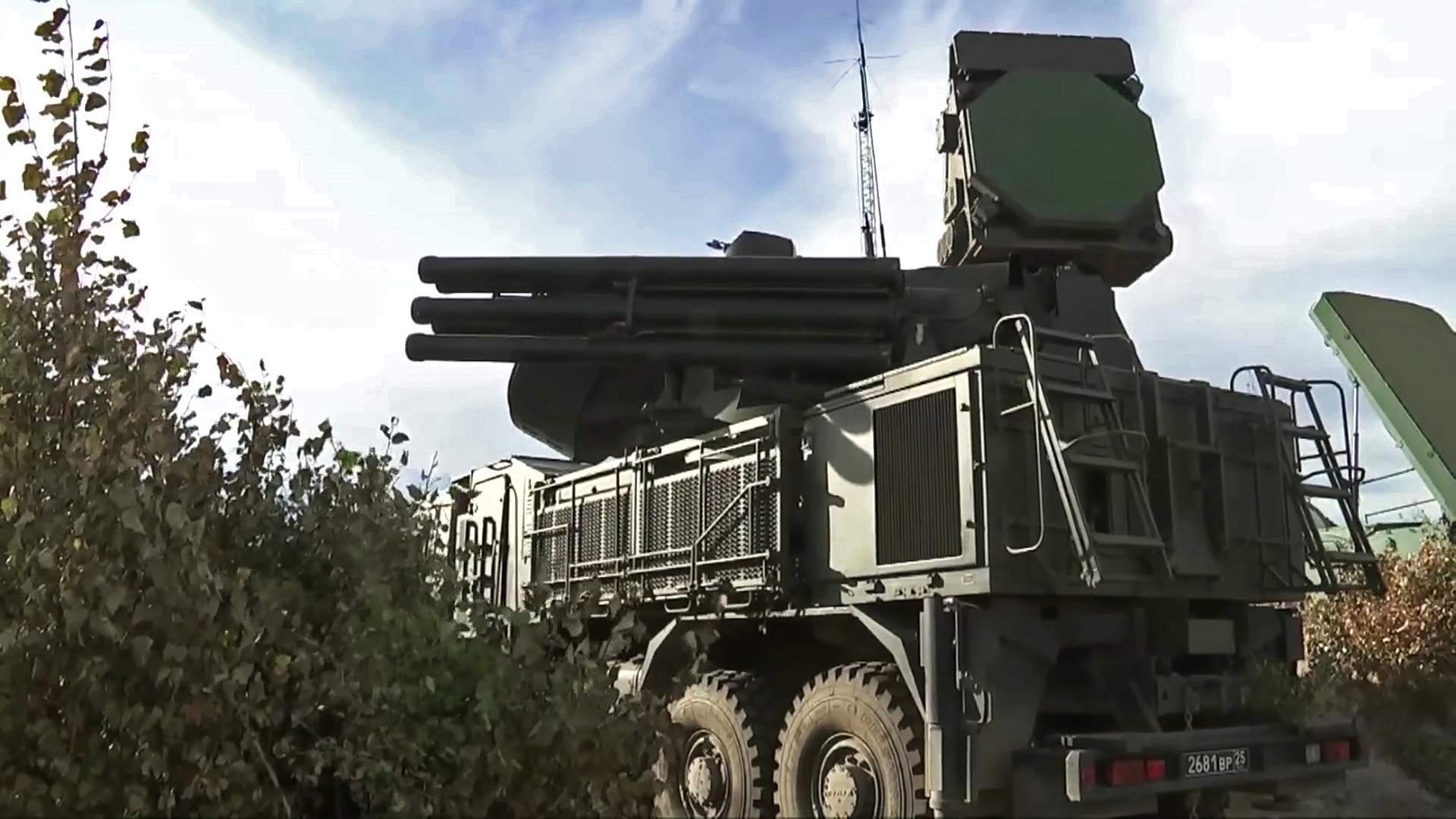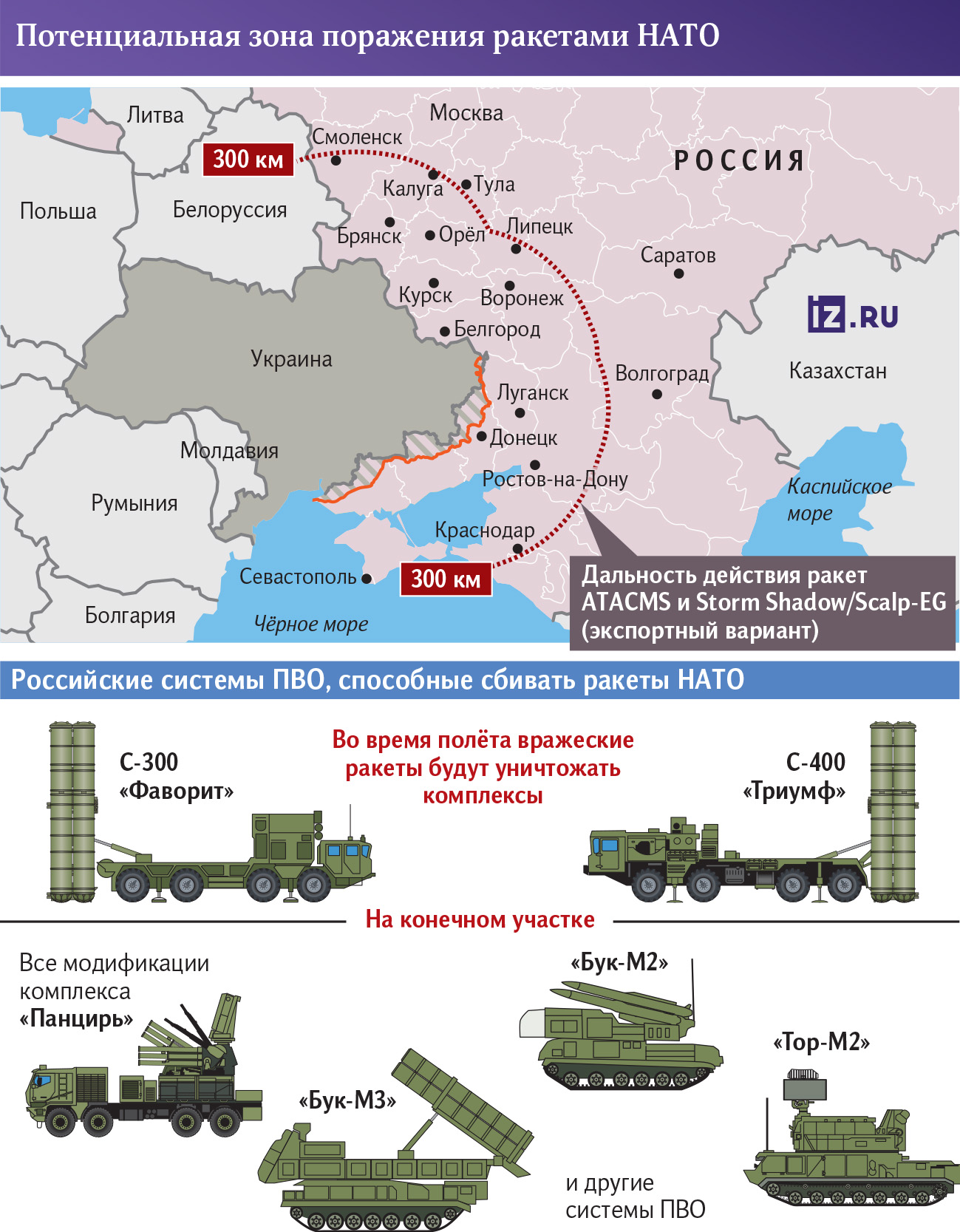Baffling: What Russia has at its disposal against Western long-range missiles

Russian air defense systems can effectively shoot down long-range missiles, experts interviewed by Izvestiya believe. The S-300 and S-400 systems can destroy them during the flight phase, and the S-350, Tora and Pantsir systems can destroy them in the final section. Nevertheless, the AFU's use of products with a range of 300 kilometers exposes the Smolensk, Kaluga, Lipetsk, Voronezh and Kursk regions, as well as Crimea and Krasnodar Krai, to potential danger. What Russian air defense means can counter the possible use of Western missiles from the territory of Ukraine - in the material of Izvestia.
What are the capabilities of air defense against Western long-range missiles?
All Russian modern air defense systems work against Storm Shadow missiles supplied to the AFU, military expert Vladislav Shurygin told Izvestia.
- "Pantsir, Tora, Buks destroy these missiles without any problems," he explained. - The S-350 Vityaz works well against ATACMS on the final trajectory, when they dive at a high angle on the target. The S-400 Triumf destroys these missiles on the flight path. When diving, they may not have time to do so. We are quite successful in shooting down these missiles - in my opinion, the hit rate does not exceed 15-20%. They will not change the situation in the course of air defense with these missiles. The AFU has a limited stock of these missiles. At best, they have two or three dozen ATACMS - and this is taking into account what they will be given. Storm Shadow - up to 15-20 missiles.
At the same time, in order to use Storm Shadow, they will need an aircraft carrier - a Su-24 airplane adapted for launching them, and there are very few of them. Now they are trying to adapt the F-16 for their launches, but it is not known whether it has succeeded, the expert concluded.
- "The potential impact zone can be imagined," Lt. Gen. Aytech Bizhev, former deputy chief of the Air Force for the unified air defense system of the CIS countries, told Izvestia. - From the area of Ukrainian-controlled Kherson, an ATACMS missile will reach Kerch, jeopardizing the Crimean bridge. From the Zaporizhzhya region, they will be able to shoot all of Crimea. Of course, the entire Kursk region is under attack. Voronezh and other important cities and districts are within the radius of these missiles. But it is important to know that we destroyed both Storm Shadow and ATACMS - there were no unsolvable issues with their destruction.
All complexes, including those of the Army Air Defense Forces, are suitable for combating these missiles, the expert noted.
- Both Tora and Pantsir will destroy them at the final site. During the flight - S-300, S-400 and others," he said.
The Russian Armed Forces need to strengthen air defense and REB means in the threatened areas, Aitech Bizhev believes.
- The range of the missiles that the AFU has is 300 kilometers," he said. - First of all, important military facilities should be removed and camouflaged there, and the same airplanes should be relocated from airfields deep into the territory. We need to strengthen the defense of important industrial and infrastructure facilities, especially nuclear facilities. The Kursk nuclear power plant and others are potential targets for the enemy. It is also necessary to change the tactics of combat operations, emphasizing countermeasures against the enemy's missiles. And this must be done quickly.
Military expert Viktor Litovkin is also confident that Russian air defense systems can effectively shoot down long-range Western missiles.
- Our S-300, S-400 and even Tor air defense systems have already shown that they can safely shoot down such targets," he told Izvestia. - But there is a question of where the Western missiles will fly, and how sudden it will be. After all, no country can create a continuous air defense field, so there is a possibility of major damage. British and French Storm Shadow/SCALP-EG missiles are still a small threat, as they are air-launched missiles, and Ukraine now has rather limited capabilities to use them.
But American ATACMS missiles pose a threat, as they can be used from a ground-based HIMARS launcher, Viktor Litovkin said.
Reports in Western media about US President Joe Biden's decision to allow Kiev to use ATACMS missiles for strikes deep into Russia appeared on November 17. US officials neither confirmed nor denied this information. At the same time, German government spokesman Wolfgang Büchner said that Berlin had been informed in advance of the US decision to authorize Kiev to strike positions in Russia with long-range missiles. At the same time, he noted that this would not change the German chancellor's decision not to supply Kiev with Taurus missiles.
Russian presidential spokesman Dmitry Peskov said on Monday that the Kremlin was only familiar with information about the authorization to strike deep into Russian territory from Western media. He noted, however, that the outgoing U.S. administration continues to fuel the conflict. "It is obvious that the outgoing administration in Washington intends to take steps to continue to add fuel to the fire and provoke further escalation of tensions around this conflict," the Kremlin spokesman said.
He also said that Moscow sees the main danger of the situation in the fact that these strikes are capable of being carried out only by Western countries, not Ukraine: targeting and maintenance of missiles are carried out by Western specialists, not Ukrainian ones. "This radically changes the modality of their involvement in the conflict," Peskov said, noting that "this is the danger and provocativeness of this situation."
What kind of missiles the AFU has and what their capabilities are
The AFU may have various Western-made long-range missile systems at its disposal. Of greatest concern are the U.S.-made GMLRS and ATACMS missile systems, which can be used with the following missiles M142 HIMARS and M270 MLRS. The problem is that the AFU today has quite a large number of launchers of these types (several dozen) and has mastered their use.
The peculiarity of using these complexes is also the fact that they have minimal deployment time and are capable of receiving information about targets in digital form immediately before striking a target. High mobility creates certain difficulties in locating the launchers and destroying them. GMLRS missiles have a range of 70-90 km.
ATACMS missiles, depending on their modifications, have a range of 140 to 300 km. The accuracy of both missiles due to correction using satellite navigation is quite high. While the U.S. stocks of GMLRS missiles are quite large, the U.S. stocks of ATACMS missiles are limited, and the U.S. is likely to ration the supply of missiles with a range of 300 km, preferring them to older modifications of missiles with a shorter range.
The vast majority of modern Russian air defense systems were built when the ATACMS missile system already existed and its capabilities were known to the developers. Accordingly, such systems as the S-300, S-400, S-350 Vityaz, Tor, Buk-M2 and Buk-M3, as well as all modifications of the Pantsir complex, can successfully defeat ATACMS-type missiles.
However, no air defense system provides a probability of defeating 100% of operational-tactical missiles, and therefore, only a multi-echelon air defense system with overlapping zones of defeat of air defense missile systems can provide a higher probability of protection of the protected object.
In addition to GMLRS and ATACMS missiles, the same launchers can use less massive, but more modern GLSDB missiles of joint U.S.-Norwegian production with a range of up to 140 kilometers.
European-made cruise missiles Storm Shadow (UK) and SCALP-EG (France) can also be used at a range of about and over 300 km. Their export versions have a range of about 300 kilometers, but standard modifications can be used at a range of up to 560 kilometers.
Supply of long-range missiles of this type is unlikely, but even 300 kilometers of range when authorized for use deep inside Russian territory significantly expands the number of objects that will be under the threat of missile attack. German Taurus missiles also have a range of up to 500 kilometers, but they have not yet been supplied by Germany to the AFU.
The appearance of missiles with a range of even 300 kilometers in the AFU exposes Russian regions as far away as Smolensk, Kaluga, Lipetsk, Voronezh, Volgodonsk, and Krasnodar to danger. If the Western countries' decision to allow the AFU to use missiles at such a range is realized, it will require strengthening air defense systems in all border regions. This will probably be done. In addition, it will be necessary to actively search for and destroy both the warehouses of Western missiles and the means of their use - carriers and launchers. As well as the destruction of headquarters infrastructure.

Переведено сервисом «Яндекс Переводчик»






